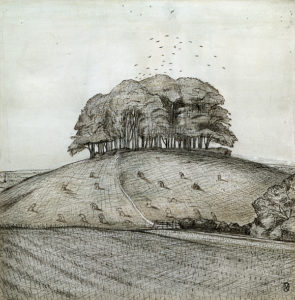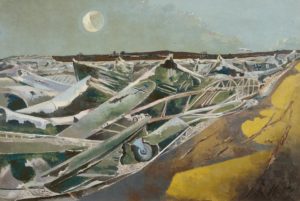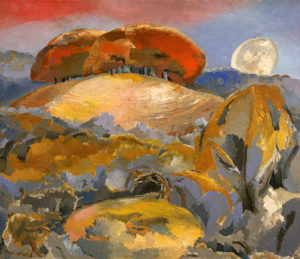 Tate Britain’s major winter exhibition ( 26th October – 5th March ) is a wide-ranging show with works from across Nash’s life and career. It costs £16.50 to enter ( £14.50 concessions ) and is most definitely worth a visit.
Tate Britain’s major winter exhibition ( 26th October – 5th March ) is a wide-ranging show with works from across Nash’s life and career. It costs £16.50 to enter ( £14.50 concessions ) and is most definitely worth a visit.
The exhibition begins with Dreaming Trees (Room 1) his landscapes of the 1910s, paintings and drawings which owe a debt to Palmer and Blake but echo forwards too, in creating a mythology of dream-scape, to Dali.  Rackham and Tenniel also spring to mind when considering his wonderful ‘Wittenham Clumps‘ and, of course, he was trained as a commercial illustrator. There is a haunting symmetry in that he returned to painting the same trees at the end of his life and this is reflected in the final room of the show, Equinox (Room 10).
Rackham and Tenniel also spring to mind when considering his wonderful ‘Wittenham Clumps‘ and, of course, he was trained as a commercial illustrator. There is a haunting symmetry in that he returned to painting the same trees at the end of his life and this is reflected in the final room of the show, Equinox (Room 10).
In between we have examples of his WWI paintings, (Room 2 We Are Making a New World) including the bleak majesty of ‘Menin Road‘. The audio commentary is particularly good here, with extracts read from Nash’s letters to his wife showing exactly how appalled and angered he was by what he saw, and painted. His war experiences changed him, as they did so many others and they changed his art. He began to use oil paints and simplified form even more than before. It was his war paintings, too, which brought him to national prominence.
The exhibition shows how, over the next decade, his art developed further,  as he sublimated and processed his war-time experiences ( though he suffered a nervous breakdown ). As before, he was very attached to specific places. Not Wittenham now, but Dymchurch on the Essex coast, where he painted the long beaches and sea defences in bold blocks of paint and Iden or Rye in East Sussex where he turned the twisting watercourses and flat marshes into planes of jagged recession, even the clouds forming serried ranks.
as he sublimated and processed his war-time experiences ( though he suffered a nervous breakdown ). As before, he was very attached to specific places. Not Wittenham now, but Dymchurch on the Essex coast, where he painted the long beaches and sea defences in bold blocks of paint and Iden or Rye in East Sussex where he turned the twisting watercourses and flat marshes into planes of jagged recession, even the clouds forming serried ranks.
He began to use reflection and form in a surreal way, acknowledging the  influence of de Chirico and other Europeans, especially in his interiors and still life paintings. The exhibition is good at illustrating this in its selection of paintings and it is easy to see his journey through surrealism, to the creation of Unit One, the British avant-garde commitment to modernism and then to the International Surrealist Exhibition in London in 1936 – Nash played a large part in organising it.
influence of de Chirico and other Europeans, especially in his interiors and still life paintings. The exhibition is good at illustrating this in its selection of paintings and it is easy to see his journey through surrealism, to the creation of Unit One, the British avant-garde commitment to modernism and then to the International Surrealist Exhibition in London in 1936 – Nash played a large part in organising it.
But, while he wrote about modernism and painted  works with a surreal quality, he could never quite let go of nature and place. He had to have something specific to set him off, even if he ended up painting it in surreal fashion.
works with a surreal quality, he could never quite let go of nature and place. He had to have something specific to set him off, even if he ended up painting it in surreal fashion.
The works I responded to most, aside from his early and late landscapes and war art were those using found objects, his collaborations with Eileen Agar ( whose shell encrusted golden human skull immediately brought a more recent diamond encrusted version to mind ). In ‘Unseen Landscapes’ (Country Life, 1938) he wrote ‘They [the landscapes] belong to the world that lies, visibly, about us. They are unseen merely because they are not perceived.‘
WWII prompted Nash into creating yet more remarkable works, this time utilising surrealist techniques of juxtaposition and transformation, like Totes Meer (Dead Sea) 1941-2 in which he turns the Cowley Dump, resting place of crashed German bombers, into a stark seascape of metal, gazed down upon by that Palmeresque moon.
utilising surrealist techniques of juxtaposition and transformation, like Totes Meer (Dead Sea) 1941-2 in which he turns the Cowley Dump, resting place of crashed German bombers, into a stark seascape of metal, gazed down upon by that Palmeresque moon.
The final rooms show Nash returning in 1942 to the painting of Wittenham  Clumps in his mature style. He painted them by day and night ( sometimes including both in the same painting ) and at different phases of the moon. It is at this time too that he paints his aerial flowers, a spinning sunflower cutting a red swathe across the downland. He died in 1946, aged 57.
Clumps in his mature style. He painted them by day and night ( sometimes including both in the same painting ) and at different phases of the moon. It is at this time too that he paints his aerial flowers, a spinning sunflower cutting a red swathe across the downland. He died in 1946, aged 57.
I have always liked Nash’s art, but the exhibition leaves me wanting to know more and to read Nash’s writings. It travels on to The Sainsbury Centre for Visual Arts, Norwich (8th April – 20th August) and Laing Art Gallery, Newcastle (9th September – end January ’18).
If you enjoyed reading this article you may also enjoy Eric Ravilious Last Chance to See War Art Georgia O’Keeffe


 RSS – Posts
RSS – Posts